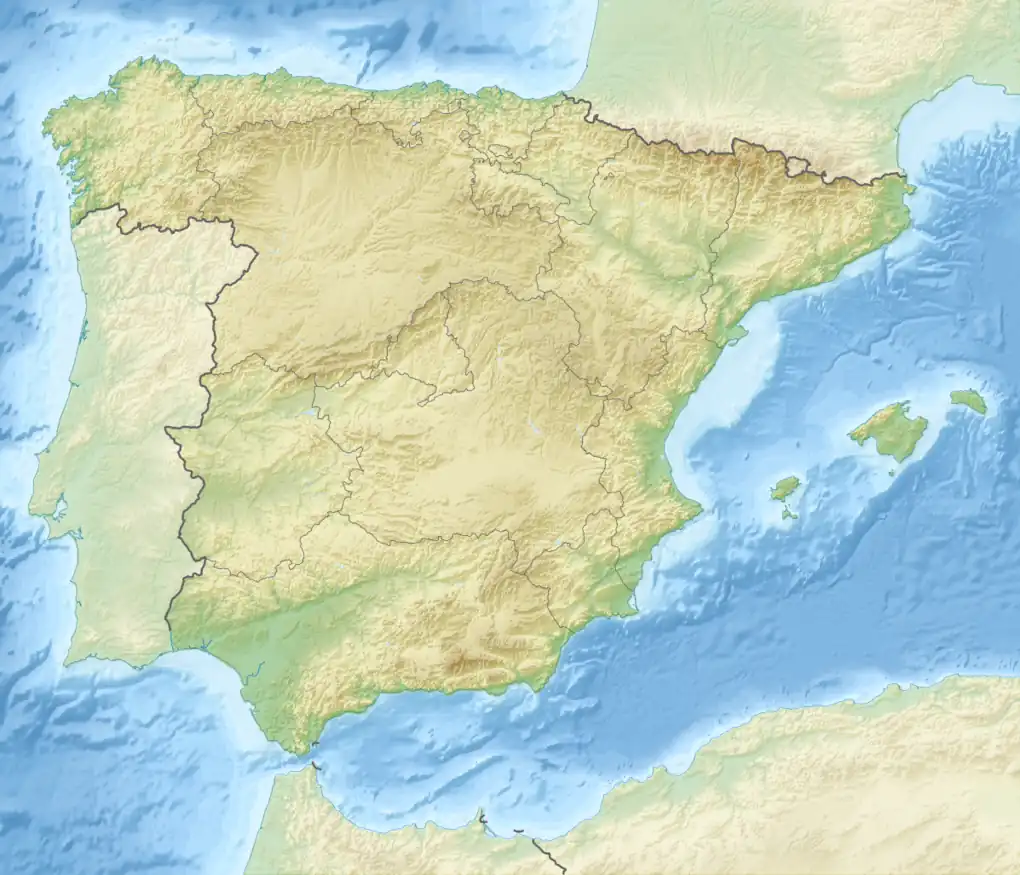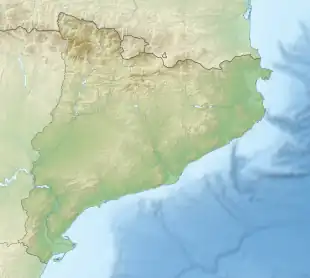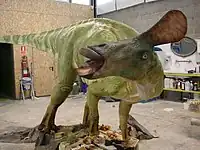| Arén Formation | |
|---|---|
| Stratigraphic range: Campanian-Maastrichtian ~ | |
| Type | Geological formation |
| Unit of | Tremp-Graus Basin |
| Underlies | Tremp Group |
| Lithology | |
| Primary | Sandstone |
| Other | Limestone |
| Location | |
| Coordinates | 42°18′N 1°36′E / 42.3°N 1.6°E |
| Approximate paleocoordinates | 34°00′N 1°36′E / 34.0°N 1.6°E |
| Region | Lérida |
| Country | |
| Type section | |
| Named for | Arén |
 Arén Formation (Spain)  Arén Formation (Catalonia) | |
The Arén Formation or Arén Sandstone (Catalan: Calcàries i gresos d’Areny)[1] is a geological formation in the Tremp-Graus Basin around Arén, Catalonia, Spain whose strata date back to the Late Cretaceous.[2] Dinosaur remains are among the fossils that have been recovered from the formation.[3] The formation dates to the Campanian to Maastrichtian and underlies the Tremp Group.
Fossil content
Dinosaurs

Dinosaur eggs (Megaloolithus baghensis,[4] Sankofa pyrenaica),[5] sauropod tracks, unnamed sauropod remains, theropod tracks, euornithopod tracks, and an unnamed iguanodont remains present in Lérida Province.
| Dinosaurs of the Arén Formation | ||||||
|---|---|---|---|---|---|---|
| Genus | Species | Location | Stratigraphic position | Abundance | Notes | Images |
| Ricardoestesia[6] | Indeterminate[6] | Lérida[7] | ||||
| Hypselosaurus[7] | Indeterminate[7] | Lérida[7] | Later found to be unknown sauropod remains[7] | |||
| Orthomerus[7] | Indeterminate[7] | Lérida[7] | ||||
| Pararhabdodon[7] | P. isonensis[7] | Lérida[7] |  | |||
| Rhabdodon[7] | R. priscus[7] | Lérida[7] |  | |||
| Titanosaurus[8] | T. indicus[8] | Lérida[7] | Later found to be indeterminate sauropod remains[7] | |||
See also
Paleontological sites of interest
-Les Serretes. It is a place in Vilamitjana municipality known by the finding of an important paleontological site. In this site there have found dinosaur remains that belongs to the Second biggest hadrosaur found in Spain, and the biggest of Catalonia. Also there have been found two carnívor dinosaur tooth that belongs to two new dinosaur species morphotypes.[9][10]
Picture of the dentary from les Serretes. Nowadays exposed on the Museum of Isona.
References
- ↑ Arengol Segú, 2014, p.31
- ↑ Arén Formation at Fossilworks.org
- ↑ Weishampel et al., 2004, pp.588-593
- ↑ Prieto Márquez et al., 2001
- ↑ López Martínez & Vicens, 2012
- 1 2 Listed as "cf. Ricardoestesia sp." in "15.8 Provincia de Lleida, Spain; 1. Arén Formation," in Weishampel, et al. (2004). Page 591.
- 1 2 3 4 5 6 7 8 9 10 11 12 13 14 15 16 "15.8 Provincia de Lleida, Spain; 1. Arén Formation," in Weishampel, et al. (2004). Page 591.
- 1 2 Listed as "Titanosaurus cf. indicus" in "15.8 Provincia de Lleida, Spain; 1. Arén Formation," in Weishampel, et al. (2004). Page 591.
- ↑ 2014, Fuentes-Buxó, R. & Dalla Vecchia, F.M. 2014. Les Serretes, a new Late Maastrichtian dinosaur site in the eastern Tremp Syncline (Southern Pyrenees, Spain). In: Paleontologia i Evolució. Reconstructing the Terrestrial end-cretaceous paleoenvironments in Europe. pp 70.
- ↑ Fuentes Buxó, R. 2012. Anàlisi de restes paleontològiques del Maastrichtià superior (Cretaci superior) procedents d’un nou jaciment situat en Les Serretes (Vilamitjana, Conca de Tremp, Espanya). Treball de fi de Master de Paleontologia (UAB-UB-ICP). 129 pp.
Bibliography
- Arengol Segú, Àngels. 2014. Guia de camp - TRANSCATALÒNIA 2014 - Comarca del Pallars Jussà (Conca Dellà i de Tremp), 1–82. Delegació Territorial de Catalunya. Accessed 2020-07-14.
- López Martínez, N., and E. Vicens. 2012. A new peculiar dinosaur egg, Sankofa pyrenaica oogen. nov. oosp. nov. from the Upper Cretaceous coastal deposits of the Aren Formation, South-Central Pyrenees, Lleida, Catalonia, Spain. Palaeontology 55. 325–339. .
- Weishampel, David B.; Peter Dodson, and Halszka Osmólska (eds.). 2004. The Dinosauria, 2nd edition, 1–880. Berkeley: University of California Press. Accessed 2019-02-21. ISBN 0-520-24209-2
- Prieto Márquez, A.; R. Gaete; A. Galobart, and L. Ardèvol. 2001. A Richardoestesia-like theropod tooth from the Late Cretaceous foredeep, south-central Pyrenees, Spain. Eclogae Geologicae Helveticae 93. 497–501. Accessed 2020-07-14.
Further reading
- N. López Martínez. 2000. Eggshell sites from the Cretaceous-Tertiary transition in south-central Pyrenees (Spain). In A. M. Bravo & T. Reyes (ed.), First International Symposium on Dinosaur Eggs and Babies, Extended Abstracts 95-115
- P. M. Sander, C. Peitz, J. Gallemi and R. Cousin. 1998. Dinosaurs nesting on a red beach?. Comptes Rendus de l'Académie des Sciences de Paris: Sciences de la Terre et des Planètes 327:67-74
- J. Gallemi, R. Martinez, and J. M. Pons. 1983. Coniacian-Maastrichtian of the Tremp Area (South Central Pyrenees). Newsletters on Stratigraphy 12(1):1-17
- A. Liebau. 1973. El Maastrichtiense lagunar ("Garumniense") de Isona [The lagoonal Maastrichtian ("Garumnian") of Isona]. XIII Coloquio Europeo de Micropaleontología 87-112
- J. Rosell. 1967. Estudio geológico del sector del prepirineo comprendido entre los ríos Segre y Noguera Ribagorzana (Provincia de Lérida) [Geological study of the pre-Pyrenean sector between the Segre and Noguera Ribagorzana rivers (Lérida province)]. Pirineos 21(75–78):5-225
- A. F. d. Lapparent and E. Aguirre. 1956. Algunos yacimientos de Dinosaurios en el Cretácico Superior de la Cuenca de Tremp [Some dinosaur localities in the Upper Cretaceous of the Termp Basin]. Estudios Geológicos 12(31/32):377-382
.jpg.webp)